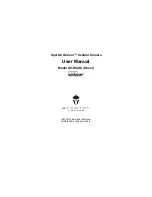
47
D-Link DCS-3112 User Manual
Section 3 - Configuration
RS-485
You may configure the RS-485 settings or communication specifications (baud rate, data bit, stop bit, and parity bit) for your camera. RS-485 is a
serial communication method for computers and devices. RS-485 is used to control a PAN/TILT apparatus, such as an external camera enclosure.
Support
PAN-TILT:
Protocol:
ID:
Baud Rate:
Data Bit:
Parity Bit:
Stop Bit:
When
Support PAN-TILT
is enabled, a control panel will be
displayed on the Live Video page allowing control through RS-485
for an external camera enclosure.
Select one protocol type from the pull-down menu.
This ID is the identifier for RS-485 devices. IDs range from 1 to 255.
Baud Rate is a speed measurement for communication between
a transmitter and receiver which indicates the number of bit
transfers per second. A higher baud rate will reduce the distance
of the two devices (transmitter and receiver). Values range from
2400 (default) to 19200 bps.
This value is the number of data bits in a transmission. The data bit can be 7 or 8 (default).
Parity is a form of error checking used in serial communication. For even and odd parities,
the serial port sets the parity bit (the last bit after the data bits) to a value to ensure that the
transmission has an even or odd number of logic-high bits. For example, if the data is 011,
for even parity, the parity bit is 0 to keep the number of logic-high bits even. If the parity
is odd, the parity bit is 1, resulting in 3 logic-high bits. Parity can be set to
No
(none),
Even
,
and
Odd
.
The stop bit is used to signal the end of communication for a single packet. The more bits
used for stop bits, the greater the lenience in synchronizing the different clocks but the
slower the data transmission rate. The stop bit can be set to 1 or 2. The default value is 1.
RS-485
Pin Block
















































